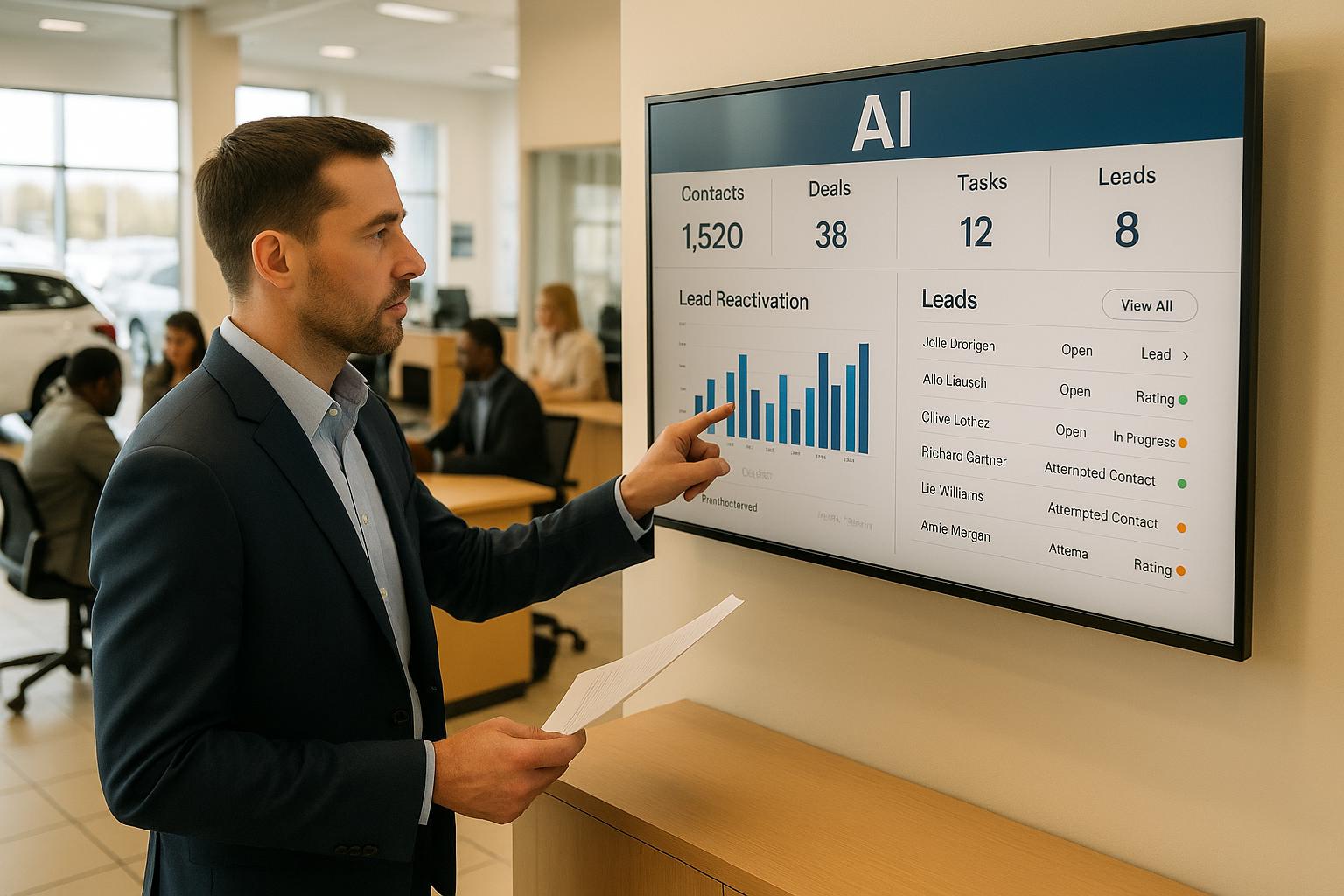AI is no longer optional for dealerships looking to reactivate dormant leads and boost revenue. Here's why:
- Missed Opportunities: Traditional CRM systems fail to effectively re-engage leads, often leaving a majority of potential customers untapped.
- Proven Results: AI tools increase lead conversion rates by 32%, reduce response times by 70%, and reactivate up to 25% of cold leads.
- Cost Savings: AI-driven automation can save dealerships up to $240,000 annually in Business Development Center (BDC) costs.
- Customer Expectations: With 83% of customers expecting immediate responses, AI ensures faster, personalized engagement that builds trust and loyalty.
- Market Shift: By the end of 2025, 50% of dealerships are expected to use AI, with those adopting it already reporting revenue growth and operational improvements.
AI transforms lead reactivation by analyzing data, automating follow-ups, and personalizing outreach. This not only improves conversion rates but also streamlines workflows, allowing sales teams to focus on high-priority leads. The time to integrate AI into your CRM is now - dealerships that act today will stay ahead in an increasingly competitive market.
How Dealers Are Using AI for Sales in 2025 | AI Sales Agents
How AI Changes Lead Reactivation
AI has completely reshaped how dealerships approach lead reactivation, turning what was once a guessing game into a precise, data-driven process. Traditional CRM systems often left sales teams wading through endless contacts without clear direction. AI, however, uses advanced tools to analyze patterns, predict behaviors, and automate outreach with pinpoint accuracy. This shift not only breathes new life into dormant leads but also integrates seamlessly with existing CRM systems.
Predictive Analytics: Reviving Dormant Leads
Gone are the days of manually sorting through stale leads. AI leverages predictive analytics to identify which dormant prospects are most likely to convert - even after long periods of inactivity. By analyzing historical data, machine learning models uncover patterns that are beyond human detection[3].
Additionally, AI systems can update outdated databases, enriching them with fresh information and turning old, unproductive records into actionable opportunities[4].
This approach delivers measurable results. For example, companies using predictive lead scoring have seen a 42% increase in sales-qualified leads. Those applying machine learning to customer data analysis report a 20–30% boost in customer satisfaction and a 10–20% rise in revenue[3].
Take Company XYZ as a case in point: by implementing an AI-driven Database Re-Ignition system, they successfully updated lead information, targeted re-engagement efforts, and converted previously cold leads into active customers[4]. This method allows sales teams to prioritize leads with the highest potential, avoiding the inefficiency of random outreach.
What’s more, AI systems constantly learn and improve. With every new data input, they become better at identifying the signals that indicate a lead is ready to buy. This self-improving capability ensures that dealerships get the most out of their lead generation investments.
Automated Follow-Ups: Consistency at Scale
Quick and consistent follow-up is critical, and AI-powered automation ensures no lead falls through the cracks. Unlike human sales teams, which can miss follow-ups due to high volumes or oversight, AI acts as an always-on sales engine, maintaining constant engagement with prospects[5].
The importance of timing cannot be overstated. Contacting a lead within five minutes makes you 100 times more likely to connect and 21 times more likely to convert compared to waiting just 30 minutes[5]. Despite this, nearly 48% of salespeople fail to follow up after the initial contact[6]. AI eliminates these delays by responding to leads in minutes, not hours or days. It can even analyze email replies to identify high-priority leads and route them to human representatives, while continuing to nurture less engaged prospects through automated sequences.
By taking over these repetitive tasks, AI frees sales teams to focus on building relationships with the most promising leads.
Personalized Messaging: Turning Interest Into Action
While automation ensures speed, personalization drives results. AI combines predictive analytics with rapid follow-ups to craft messages tailored to each lead’s specific needs. Forget generic, one-size-fits-all emails - AI analyzes prospect data to create outreach that feels personal, addressing individual pain points, goals, and behaviors[8].
The benefits are clear. Targeted, relevant emails can generate up to 18 times more revenue than generic ones, and personalized content boosts response rates by around 32% on average[8]. Companies that prioritize personalized outreach typically see a 40% increase in revenue compared to those sticking to generic campaigns[8].
Consider Landbase’s success: their AI-driven personalization strategy achieved a sevenfold increase in conversion rates compared to standard campaigns[8]. Similarly, a UK-based SaaS company segmented LinkedIn leads into "scaling startups" and "early-stage founders", tailoring messages to each group. The result? A 50% response rate and 20 demo bookings in just one month[10].
"We have a specific understanding of how a receiver will relate to a message... enabling us to hyper-personalize a message that's very human-like and has a much higher chance of succeeding."
- Daniel Saks, Landbase CEO[8]
AI goes far beyond simply inserting names into templates. It analyzes customer support interactions, call transcripts, and behavioral trends to build dynamic profiles based on actual buyer behavior. Using this data, it optimizes everything from message timing and subject lines to calls-to-action and communication channels - all in real time[7].
The results speak for themselves. Personalized messages achieve 40% higher acceptance rates, targeted content generates 50% more engagement, and automated nurturing increases conversion rates by 25%[10]. With 77% of B2B buyers preferring personalized content during the purchasing process, dealerships using AI personalization gain a clear edge over competitors[9]. As Forbes puts it, "personalization is no longer a nice-to-have, but a must-have"[9]. Personalized email campaigns, for instance, deliver 14% higher conversion rates and drive six times more transactions than generic ones[8][9].
Adding AI to Your CRM System
Bringing AI into your CRM system doesn’t have to feel like a massive undertaking. With 80% of dealerships already using or planning to adopt AI solutions by 2025, the question has shifted from if to how to make the most of this technology. The secret? Thoughtful planning, smooth integration, and selecting tools that enhance - not disrupt - your existing processes.
Easy Integration with Current Workflows
Today’s AI tools are designed to work within your existing CRM setup, improving functionality without complicating your tech stack.
Take the example from April 2025: DriveCentric partnered with AutoFi to create an AI-powered automotive CRM integration. This allowed sales and finance teams to work more efficiently by enabling sales staff to search DriveCentric CRM by name, email, or phone directly within AutoFi. With just one click, customer details could be imported seamlessly [11].
"This integration is another example of how DriveCentric is helping dealers simplify their tech stack while improving the customer experience." - Philip Fusz, President at DriveCentric [11]
The impact was immediate. Chris Morris, VP of Operations/Operating Partner at Hello Auto Group, reported noticeable improvements in dealership performance following the integration [11].
To ensure a smooth rollout, start by evaluating your IT infrastructure to confirm it’s ready for AI. Clearly define your goals, align them with your broader business strategy, and prepare clean, standardized data - this is the foundation of any successful AI implementation [12].
Consider starting with pilot programs or phased rollouts. This lets you test the technology, train your team at a manageable pace, and address any issues without disrupting daily operations [12].
Once your CRM is integrated with AI, you can turn your focus to optimizing response times - an area where AI truly shines.
Speed-to-Lead Optimization
After integration, one of the quickest wins AI can deliver is faster lead response. Studies show that leads contacted within five minutes are 21 times more likely to convert, and 78% of customers go with the first company to respond.
AI-driven speed-to-lead optimization takes the guesswork out of lead management. It instantly analyzes incoming leads, assigns them to the most suitable sales rep based on expertise or availability, and can even trigger automated responses while your team prepares for follow-up.
For example, VisQuanta’s AutoMaster Suite automates first-contact management directly within your CRM. Rather than replacing your sales process, it speeds it up - ensuring no lead is left waiting and every opportunity gets immediate attention.
These AI tools integrate fully into your CRM, working alongside your existing workflows without disrupting them [14]. They also adapt over time, learning your team’s habits to refine processes like identifying the best times to contact leads, selecting the right communication channels, and crafting effective messaging.
Data-Driven Insights for Sales Strategies
AI doesn’t just make your CRM faster - it makes it smarter. By analyzing customer behavior, past interactions, and conversion trends, AI transforms your CRM into a strategic tool for sales planning.
For instance, AI can identify dormant leads that are most likely to re-engage. It uses data like previous activity, time since last contact, seasonal buying trends, and demographic details to create lead scoring models that help your team focus on the most promising opportunities.
It also uncovers performance patterns within your sales team, highlighting which approaches resonate with specific customer segments. This allows managers to offer precise coaching and replicate successful strategies across the team.
To keep your AI tools performing at their best, set up regular monitoring. Track metrics like response times, conversion rates, and customer satisfaction scores to continuously refine your system [12].
Beyond individual leads, AI provides insights into broader market trends. It can predict seasonal demand shifts, suggest inventory adjustments, and help you stay ahead of market changes by analyzing lead behavior and conversion data. These insights enable dealerships to make smarter, data-backed decisions that improve overall operations.
Benefits of AI-Driven Lead Reactivation
AI-driven lead reactivation offers tangible results that directly enhance your dealership's performance. By leveraging AI tools to re-engage dormant leads, dealerships can see marked improvements in three key areas: conversion rates, customer satisfaction, and operational efficiency.
Higher Conversion Rates
AI revolutionizes how dealerships manage leads, enabling smarter targeting and quicker response times. By analyzing customer behavior, purchase history, and engagement patterns, AI identifies dormant leads with the highest potential to convert. This allows your sales team to focus their energy where it matters most.
Take Available Car, a leading UK used car retailer, as an example. By adopting AI-driven personalization, they achieved 62% higher appointment rates and pre-qualified an impressive 3,600 leads in just three months - all while maintaining 30% conversion rates [16].
The advantages don’t stop there. AI-powered systems can cut lead qualification time by 40–60% and boost sales team productivity by 15–30% [16]. For instance, Glyn Hopkin & Endeavour Automotive saw a "substantial surge in qualified leads" and reported cross-departmental sales growth after integrating AI into their lead management processes [16].
While boosting conversions is a major win, AI also enhances customer interactions, making them more meaningful and efficient.
Better Customer Satisfaction
AI-driven reactivation doesn’t just improve numbers - it also creates a better experience for customers. Through personalized, timely, and consistent communication, dealerships can foster trust and loyalty. Businesses using AI tools report a 3.5% increase in customer satisfaction rates [15].
By analyzing past interactions and preferences, AI crafts tailored messages that resonate with potential buyers. This personalized approach builds trust even before a customer steps onto the lot. And with 83% of customers expecting immediate responses when contacting a business, AI-powered tools like chatbots and automated systems help meet these expectations [15]. These tools can respond instantly to inquiries, schedule test drives, and provide answers around the clock, ensuring no customer feels ignored.
When customers receive timely and relevant responses - whether about vehicle availability, financing, or service options - their satisfaction naturally increases, setting the stage for stronger relationships.
Improved Operational Efficiency
AI doesn’t just improve customer interactions; it also streamlines dealership operations, making them more efficient and cost-effective.
Repetitive, time-consuming tasks like sorting through old leads or crafting follow-ups are automated by AI, freeing up your sales team to focus on closing deals and building relationships. For example, AI-powered financing tools can reduce loan approval times by 70%, helping prevent delays that might cause potential buyers to lose interest [2]. This speed keeps the sales process moving smoothly while reducing the workload on your team.
AI also optimizes resource allocation by identifying which leads need immediate attention and which can be nurtured through automated follow-ups. Digital campaigns powered by AI can achieve 30% higher engagement rates, all while cutting down on wasted marketing spend [2].
Beyond lead management, AI offers additional benefits like better inventory forecasting, predicting seasonal demand shifts, and providing actionable insights for strategic decision-making. These operational enhancements make dealerships more agile and better equipped to adapt to market changes and evolving customer preferences.
How to Implement AI Solutions Successfully
Implementing AI effectively in a dealership requires a thoughtful approach that combines choosing the right tools, equipping your team with proper training, and maintaining a process of continuous improvement. The difference between success and failure often boils down to how well these steps are planned and executed.
Choosing the Right AI Tools
The first step is selecting AI tools that align with your dealership's specific needs and work seamlessly with your existing CRM system. Not every AI solution will be a perfect match, so it’s crucial to evaluate your options carefully.
Start by assessing your current CRM's capabilities and identifying any gaps. Look for AI platforms that can integrate smoothly with your existing setup without requiring a complete overhaul. For instance, VisQuanta's AutoMaster Suite enhances existing CRMs by adding automation and reactivating dormant leads.
Data quality is critical. AI systems are only as effective as the data they process. Choose solutions that can handle incomplete or messy data and include features for data validation. For example, platforms that use phone numbers as a master reference can consolidate customer information and eliminate duplicate profiles [17].
The impact of selecting the right tools is clear. Ardmore Toyota, for instance, ran hyper-personalized campaigns for every CRM lead, re-engaging 40,900 inactive leads and converting 11,400 into active shoppers. This effort led to 94 sales and $2.4 million in new revenue. Similarly, Mt. View Chevrolet used AI for VIN-level marketing and, within two weeks, achieved a 170% increase in VDP views and a 145% boost in active shoppers.
Real-time synchronization is key. Ensure the tools you choose provide seamless updates between systems so your sales team always has the most accurate information. With 68% of dealerships reporting improved operations after adopting AI [17], the benefits of selecting the right tools are undeniable.
Once the tools are in place, the next step is ensuring your team knows how to use them effectively.
Training Sales Teams for AI Use
Even the best AI tools won’t deliver results if your sales team isn’t equipped to use them. Proper training is often a stumbling block, but it’s also where the biggest opportunities lie.
Evaluate your team’s current skill set and pinpoint gaps. Tailor training sessions to address these specific needs rather than relying on generic programs [18].
Keep training practical and relevant. Show your sales team how AI can make their day-to-day tasks easier. For example, demonstrate how automated follow-ups can save them time, allowing them to focus on high-priority leads. Highlight how predictive analytics can help identify which leads are most likely to convert.
Consider using AI conversational coaching tools to provide personalized, ongoing training that adapts to each team member's pace and style [18].
"If you're not leveraging AI to identify customer needs before they do, you're falling behind." - Brian Benstock, Partner, VP & GM of prominent Honda and Acura dealerships [19]
Explain the reasoning behind AI recommendations. When your team understands how AI analyzes customer behavior and generates insights, they’re more likely to trust and act on its suggestions. For instance, showing how the system identifies patterns in purchase history can help them see the value in AI-driven actions.
The stakes are high - every 1% increase in sales productivity can translate to $500,000 in additional annual revenue [17]. Comprehensive training ensures you’re getting the most out of your AI investment.
After training, maintaining momentum through ongoing support and optimization is essential.
Getting Ongoing Support and Optimization
Implementing AI isn’t a one-and-done project. It’s an evolving process that requires regular adjustments and support to keep delivering results. Successful dealerships treat their AI provider as a long-term partner.
Set clear performance metrics from the start. Track key indicators like lead response times, conversion rates, and revenue from reactivated leads. For example, Szott Ford re-engaged 7,496 previously inactive leads, converting 958 into active shoppers and generating 9 sales within six months.
Schedule regular system updates. Work with your AI provider to review and fine-tune your tools periodically. This ensures they remain aligned with your dealership’s goals and continue to perform at their best.
Ensure access to ongoing technical support. Quick issue resolution is crucial. Look for providers that offer comprehensive support, including troubleshooting, training refreshers, and system optimizations.
The AI landscape is evolving rapidly, with the automotive AI market projected to grow at 24.1% annually through 2027 [17]. Keeping your tools updated and leveraging new features is essential to staying competitive.
Document effective strategies and outcomes. Maintain detailed records of what works best for your dealership, which customer segments respond to AI-driven outreach, and how conversion rates shift over time. These insights are invaluable for refining your approach and training new team members.
With 52% of executives planning to expand AI use [17] and 35% of dealerships in the Get My Auto network already using AI solutions (expected to reach 50% by late 2025) [1], staying proactive with optimization is no longer optional - it’s a necessity in today’s market.
Conclusion: The Future of Lead Reactivation with AI
The dealerships embracing AI-driven lead reactivation today are positioning themselves to dominate the market in 2025 and beyond. The data speaks for itself - dealerships are seeing notable increases in conversion rates and successfully reactivating leads that were previously dormant [20].
As of early 2025, 35% of auto dealerships have integrated AI into their operations, and that figure is projected to hit 50% by the end of Q4 [20]. This surge in adoption isn’t driven by buzzwords - it’s backed by tangible outcomes. Dealerships leveraging AI in their sales processes consistently report better operational efficiency and higher revenue. For instance, AI-powered follow-up workflows are generating over $200 in additional profit per vehicle sold [20]. These results highlight how AI is reshaping the way dealerships operate.
AI doesn’t just tweak existing processes - it transforms them. Take the example of a Get My Auto dealer group that, in March 2025, implemented Ava AI alongside the Get My Auto CRM. The results? A 40% boost in lead-to-appointment ratios, a 33% reduction in the time from first contact to sale, and a 30% decrease in BDC staffing needs - all without compromising performance [20].
This shift is making the car-buying journey faster, smarter, and more tailored to individual customers [20]. Dealerships are moving away from manual workflows and embracing automation, predictive analytics, and data-driven strategies [2]. Importantly, this isn’t about replacing sales teams - it’s about equipping them with tools to perform better.
The time to act is now. Begin with AI-powered chat solutions, then expand into AI-enhanced websites, CRM workflows, and inventory remarketing [20]. Train your team to understand AI-generated lead scores, monitor KPIs weekly, and integrate AI into your existing systems to ensure seamless data sharing [20].
VisQuanta’s AutoMaster Suite provides a clear path forward. With its CRM integration, automated database reactivation, and robust support, it helps dealerships tap into the potential of dormant leads while staying ahead in a competitive market.
The dealerships that seize this opportunity today will lead the industry tomorrow. AI-driven lead reactivation is no longer optional - it’s the standard. The future starts now.
FAQs
How does AI-driven lead reactivation help small and medium-sized dealerships succeed?
AI-powered lead reactivation gives small and medium-sized dealerships a real edge by improving lead-to-sale conversions and leveling the playing field against larger competitors. Through automated follow-ups, personalized messaging, and predictive analytics, it ensures every lead is nurtured and every interaction feels custom-made for the customer.
Beyond just improving outreach, this technology simplifies sales workflows, freeing up time and resources for teams to focus on closing deals and enhancing customer experiences. For smaller dealerships, these tools provide a way to recapture missed sales opportunities and boost profitability in a highly competitive automotive market.
How can car dealerships successfully integrate AI into their CRM systems?
To bring AI into your CRM system successfully, start by assessing your dealership's current technology setup and the quality of your data. The right AI solution should address your specific needs - whether that's predictive analytics, automated follow-ups, or something else tailored to your goals. Make sure your CRM data is clean, current, and properly organized to ensure smooth integration.
Next, focus on preparing your team. Offer thorough training so they can use the AI tools effectively, and establish clear objectives for how the technology will enhance lead reactivation. Before rolling it out completely, conduct detailed testing to spot and fix any potential issues. Once live, keep the momentum going with continuous training and support to ensure your staff remains confident and the AI system runs smoothly over time.
What challenges do dealerships face when adopting AI for lead reactivation, and how can they address them?
Dealerships face a range of hurdles, including keeping their data accurate and streamlined, protecting customer privacy, and integrating AI into their current systems without causing disruptions.
To tackle these challenges, consider starting with data management tools that help clean up and organize your CRM records, ensuring everything is up-to-date and easy to use. Strengthen your defenses by implementing robust cybersecurity protocols to safeguard sensitive customer information and maintain trust. When it comes to AI, take a gradual approach - introduce it step by step, and make sure your team receives the training and support they need for a seamless transition and sustained success.
.avif)











.svg)

